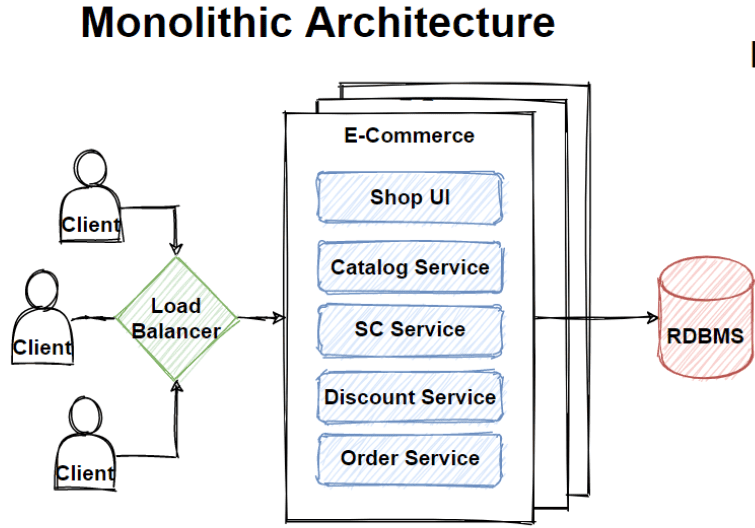Monolithic architecture is an approach to software development in which an application is built as a single, self-contained unit. In this architecture, all application components are tightly coupled and run within the same process. This means that the entire application is deployed as a single package, and all changes to the application require the application to be rebuilt and redeployed.
In a monolithic architecture, the application is typically divided into three layers: the presentation layer, the business logic layer, and the data storage layer. Each layer is tightly integrated with the other layers, and any changes to one layer can affect the different layers.

In the above example, we can see that all services are created in a single application and they are tightly coupled with each other. Even functionalities created in separate classes, it is integrated into the main class. If the change in one class is done, we have to test all functionality. The bigger issue is that, if any class has an issue then it will impact all functionality. Let us example, the discount service has an issue so it will impact the complete order process.
Disadvantage of Monolithic architecture
Monolithic architecture has some disadvantages that can make it unsuitable for certain types of applications or scenarios. Here are some of the main disadvantages:
Lack of Scalability
Scaling a monolithic application can be challenging. Since all components are tightly coupled, scaling the entire application is often required, even if only a specific component or module needs additional resources. This can result in inefficient resource utilization and increased costs.
Limited Technology Flexibility
Monolithic architectures typically use a single technology stack throughout the entire application. This limits the flexibility to use different technologies or frameworks that might be better suited for specific components. It can hinder the adoption of new technologies and innovations.
Lack of Development Agility
In a monolithic architecture, developers often work on the same codebase, making it challenging to work in parallel or adopt different development methodologies. It can slow down the development process and limit the ability to quickly respond to changing business requirements.
Deployment Complexity
Updating or deploying changes to a monolithic application can be complex and risky. Since all components are bundled together, even a small change may require redeploying the entire application. This can lead to longer deployment cycles, increased downtime, and the potential for introducing bugs or errors.
Maintenance Challenges
Monolithic applications can become difficult to maintain and evolve over time. As the application grows in size and complexity, understanding the dependencies between components, making changes without unintended side effects, and ensuring proper testing becomes more challenging.
Resilience and Fault Isolation
A failure in one component of a monolithic application can impact the entire system. It lacks the fault isolation capabilities of microservices, where failures can be contained to specific services without affecting the entire application.
Team Collaboration
Monolithic architectures can hinder collaboration among development teams. Since multiple teams often work on the same codebase, conflicts may arise, and coordinating changes becomes more challenging.
Advantage of Monolithic architecture
Simplicity
Monolithic architecture provides simplicity in development, deployment, and management. Since all components are bundled together as a single unit, there is no need to manage complex inter-service communication or deploy and coordinate multiple services.
Performance
In monolithic architecture, components within the application can directly access shared memory and resources. This direct communication can result in better performance compared to the network latency that may be involved in microservices’ inter-service communication.
Easier Debugging and Testing
With all components running within the same process, it is often easier to debug and test the application as a whole. Developers can step through the codebase, analyze the state of the application, and identify issues more effectively.
Shared Codebase
Having a single codebase simplifies version control, collaboration, and knowledge sharing among developers. It promotes a cohesive development environment where developers have a holistic view of the application.
Lower Operational Overhead
Monolithic applications require fewer resources and less complex infrastructure compared to distributed architectures like microservices. This can result in lower operational overhead in terms of hosting, monitoring, and management.
Rapid Development
Monolithic architecture allows for rapid development, especially for small to medium-sized applications with straightforward requirements. The focus is on building and delivering the application as a whole, without the need for complex coordination between services.
Legacy Systems
In certain cases, monolithic architecture may be suitable for maintaining or integrating with legacy systems. If a system is already built in a monolithic fashion, it might be more practical to continue operating and maintaining it without significant changes.
Summary
Monolithic architectures are suitable for small to medium-sized applications with relatively simple functionality and low complexity. They offer simplicity in development and deployment since all components are bundled together. However, as the application grows in size and complexity, monolithic architectures can become harder to manage, maintain, and scale. Changes to one component may require redeploying the entire application, limiting agility and scalability.
In recent years, microservice architecture has gained popularity as an alternative to monolithic architecture, offering benefits such as scalability, flexibility, and easier maintenance for larger and more complex applications.
References
Pattern: Monolithic Architecture
Other Posts
TOP 10 BEST PRACTICES FOR LIGHTNING FLOW
TOP 10 ENTERPRISE INTEGRATION USE CASES
TOP 10 SALESFORCE SECURITY BEST PRACTICES

3 comments
[…] What is Monolithic Architecture? […]
[…] What is Monolithic Architecture? […]
[…] What is Monolithic Architecture? […]